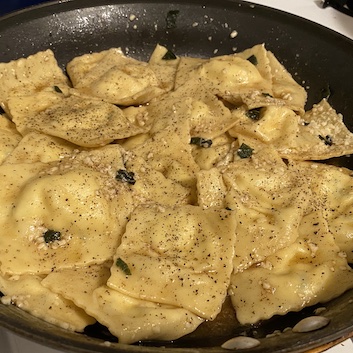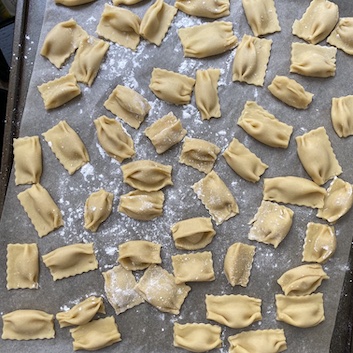Homemade Pasta Recipe

As someone who grew up on cooking competitions (OG dubbed Iron Chef, anyone?), I was always intimidated by homemade pasta and how many fierce competitors it seemed to take down. But turns out once you have the right tools it's a piece of cake.
What follows is the base recipe I use, but there's no substitute for following your instincts. Dough seem like it's drying out? Incorporate a little bit more moisture and knead until you get the elasticity you're looking for. Dough too wet? Add in a bit of flour until it seems workable. Take it from me: you don't want to put your pasta roller up against too wet dough!
Ingredients
- 2 cups flour, plus more for dusting
- 2 eggs, plus 3 egg yolks
Tips
- Search for 00 flour if you can find it, but all-purpose flour will work too.
- Trust what you're feeling: eggs are all different weights and you may need more or less moisture.
- Yes it really is important to rest the dough if you don't want to fight it while you're rolling it out.
- You don't need a pasta roller, but rolling it out by hand is going to make it much harder.
Directions
- Heap your flour on the counter or in a large bowl and create a crater in the center. Add your eggs and yolks.
- Use a fork to beat the eggs and begin incorporating the flour a bit at a time until you have a shaggy dough.
- Switch to your hands, mixing in the remaining flour and beginning to knead it together into one ball of dough. This is where you may need to add a small amount of water if too dry, or add a bit of flour if it seems too wet.
- Move the dough to the counter if you've been working in a bowl, and make sure your counter is lightly floured. Knead five minutes or so until your ball of dough is smooth and elastic seeming.
- Cover the dough with plastic wrap and let it rest at room temperature for 30 minutes to 2 hours.
- Quarter your dough and take one quarter to work with, cover the rest with plastic wrap.
- Make a flat slab of dough from your quarter and feed the dough through your pasta roller on the widest setting. Fold the dough in thirds and roll it through again. Repeat until you have a silky, thick sheet of pasta.
- Begin putting the dough through on progressively thinner settings, twice on each setting. Flour is your friend: use it to prevent sticking along the way. Your sheets are ready when you can start to see your hand through the dough.
Once you have pasta sheets, the world is your oyster! You can cut the sheet into longer pasta shapes or explore filled and shaped pastas. Keep in mind, you will want a thinner sheet for a ravioli or other doubled-over dough than for a fettucinne or spaghetti.


